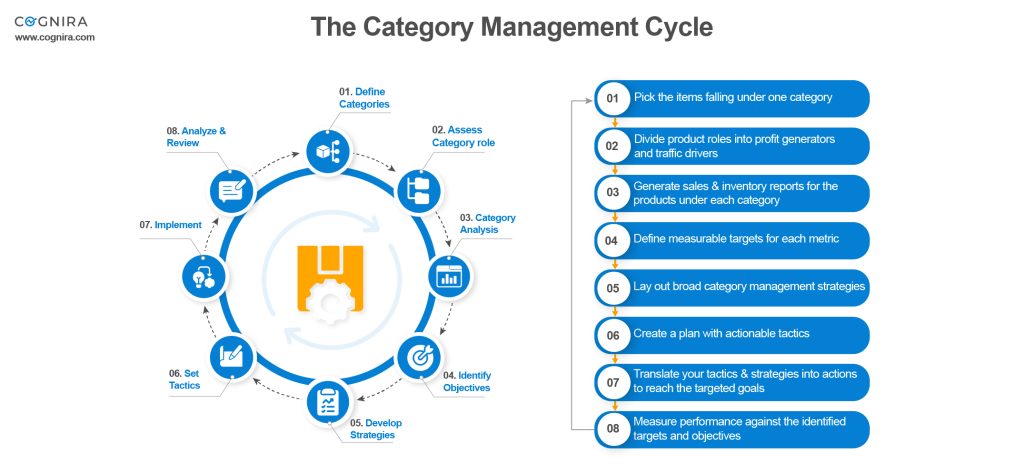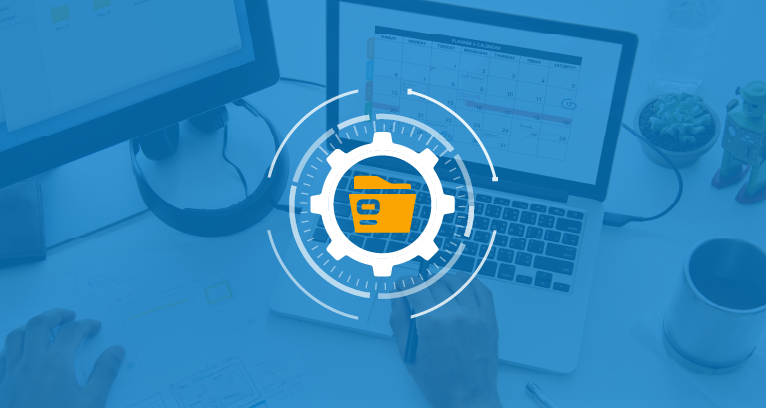Promotion Planning in retail is no mere linear path, as it represents a web of interconnected workflows, operations, and roles that link up to deliver the final product. From analyzing historical data and looking into industry and consumer trends to creating a campaign and overseeing pricing and promotions, category management plays a pivotal role in most of these processes, bridging the gap between data analysis and actionable insights.
Without an efficient category management process, retailers might lack a strategic approach to promotions, with no consideration of the unique characteristics of each product category or even customer segment. The inclusion of a coherent category management process within promotion planning can put an end to the promotion havoc and avoid missed cross-selling opportunities amidst other benefits we will be seeing throughout this blog.
What is category management?
When a big-box retailer has numerous listed SKUs across multiple product departments, a need to manage each category separately arises, to maintain full visibility of its performance and keep an eye on its ROI for strategic promotion planning and resource allocation. To put it simply, category management is the act of bundling similar items and products into a single category based on particular characteristics, ensuring that it operates efficiently and unlocking its full potential, while improving the consumer’s shopping experience.
It is worth noting that businesses have specific classifications to define these categories, and these SKUs might differ from one retailer to another. For example, Amazon’s Arts & Crafts category includes painting supplies, fabrics, stamps, and storage containers amongst many other items.
Implementing such a process guarantees that every SKU grouped under a pre-determined category is being observed closely and strategically managed, making sure it receives the attention it deserves. All purchases, merchandising, inventory management, sales, and other retail efforts within the category are managed by a category manager, which leads us to ask the following question:
What is the role of a category manager?
Category managers, often referred to as “Catmans”, are responsible for organizing and managing product categories within a retail environment, therefore finding, promoting, and reviewing products and merchandise for companies. They also evaluate suppliers and collaborate with vendors to develop merchandising strategies and initiatives.
To put it simply, “catmans” are the ones managing product categories to improve their performance and make sure that their potential is maximized while ensuring consolidation and achieving savings through economies of scale. Such a feat is achievable through a combination of actions, starting with defining categories and tracking their performance and ending up with marketing strategies development and implementation, reviewing results, and making adjustments accordingly.
A more detailed illustration of the category management cycle is provided below:

What are the benefits of category management?
A well-tailored promotion strategy does not revolve around throwing discounts at random items, as there must be a strategic role created to achieve a specific goal within the product category. This is where category management steps in, providing a profound understanding of product offerings and customer base and forming the basis for effective promotion planning in retail. Let’s explore how category management can increase promotion planning effectiveness and empower retailers to craft promotions that resonate with their audience and deliver measurable results:
Effective buying:
Category managers don’t budget based on sales history, but rather focus on trend monitoring, historical sales insights, and all factors affecting the negotiations with suppliers. This analytical approach will put more insights into the sales forecast of the category’s products, improving profit margins and leading to more effective buying.
Optimized assortment planning:
Pinpointing small-moving inventory is one of the tasks assigned to the category manager, where he identifies slow-moving inventory and underperforming SKUs within a category. Accordingly, this allows focus on high-demand items and eliminates redundant items that immobilize capital and require storage space.
Negotiation power:
By bundling products into categories, retailers gain a 360-degree view of their total spend within a particular category. With each category manager leading the buying process for multiple stores simultaneously, they can resort to bulk buying to secure better deals, payment, and shipping terms, offering them greater flexibility when handling negotiations with suppliers.
Data accessibility:
It lays the foundation for centralized communication and collaboration between category managers, retailers, and suppliers, making data more accessible for more informed decision-making. The centralized category management process facilitates negotiations between all parties, guaranteeing faster fresh items negotiation management and enhanced pricing strategies.
Improved profit margins:
By identifying opportunities for cost reduction across procurement channels, analyzing emerging trends, and identifying areas for improvement, category management enables the measurement of the effectiveness of every tactic and strategy. This strategic approach not only optimizes operations but also boosts profit margins.
Data-driven decision-making:
To decipher consumer behavioral patterns and preferences and understand supplier performance, a category manager must leverage both historical and real-time data. This data-driven approach guarantees that pricing, promotions, and vendor selection decisions are taken after careful consideration of data and not solely based on gut feeling.
Maximized performance:
From negotiations and buying to visual display and sales performance management, a category manager warrants careful monitoring of all operations within each category. By working separately on each category, he will ensure that their performance is maximized to their full potential.
How can category management increase promotion planning effectiveness?
A well-tailored promotion strategy does not revolve around throwing discounts at random items, as there must be a strategic role created to achieve a specific goal within the product category. This is where category management steps in, providing a profound understanding of product offerings and customer base and forming the basis for effective promotion planning in retail. Let’s explore how category management can increase promotion planning effectiveness and empower retailers to craft promotions that resonate with their audience and deliver measurable results:
Predictive analysis:
A category manager has the ability to see the “big picture” of his category, with a deeper understanding of trends, market fluctuations, and customer behavior. When coupled with the efficient use of data-driven tools, a good product and pricing elasticity analysis enables category managers to predict how their category will perform, leading to more accurate forecasting and effective planning of promotions.
Sharper cutomer targeting:
Category management goes beyond plain demographics, analyzing buying habits and behavioral patterns inside a category and identifying consumer preferences. Such a feat paves the way for better targeting during promotion planning, serving consumers with a good appetite for that promotion.
Strategic assortment:
Catmans analyze how products within a category interact with each other, which simplifies the process of identifying complementary and substitute products. In other words, category management predicts when a product will cannibalize the sales of another one, or how an item will increase the sales of another, a situation that is widely known as “the halo effect”. The analysis of such effects empowers catmans to maximize profitability, reduce surplus stock, and effective promotion planning.
Customer-Led Category Management (CLCM):
By putting customers first, Catmans craft a customer-led value proposition that delights priority customer segments, accelerating category growth through a complicated process. This process starts with creating a consumer persona, understanding their spending incentives and deterrents, and creating a sustainable promotion planning model.
Data-driven promotions:
Category management is all about processing data to make category-centric decisions, unlocking valuable insights that inform targeted promotions and maximize their effectiveness. Particularly, this process generates valuable insights (customer segmentation, product relationships, etc) that can be leveraged to craft promotions with laser precision.
Category management serves as the bridge between understanding your products and understanding your customers, assisting catmans and merchants’ efforts to plan and execute promotions strategically. It also enables them to craft data-driven promotions that go beyond just discounts and gut-feeling-based offerings, transforming your promotion planning game from gambling and taking gut-based decisions to a data-driven approach that fuels category growth and profitability.
Conclusion
Category management is no longer a buzzword, as it’s the backbone of strategic promotion planning in retail. Such a process revolves around data, but also orbits informed decision-making that enables the planning and execution of personalized and targeted promotions that drive results, boost ROI, and improve profit margins.
Cognira’s PromoAI solution is an end-to-end platform that revolutionizes the way promotions are planned and executed. Our solutions empower category managers to seamlessly collaborate with vendors and merchants across platforms, facilitating negotiations and leading to sharper targeting. Leverage the power of AI and analytics to enable customer-led category management for better promotions and better results.

